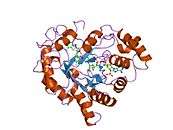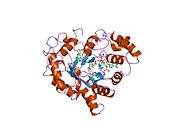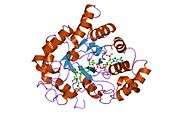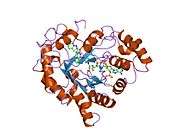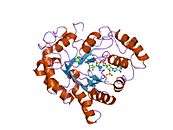AKR1B1
| View/Edit Human | View/Edit Mouse |
Aldo-keto reductase family 1, member B1 (aldose reductase), also known as AR, is an enzyme that in humans is encoded by the AKR1B1 gene.[4][5]
Function
This gene encodes a member of the aldo/keto reductase superfamily, which consists of more than 40 known enzymes and proteins. This member catalyzes the reduction of a number of aldehydes, including the aldehyde form of glucose, and is thereby implicated in the development of diabetic complications by catalyzing the reduction of glucose to sorbitol.[5]
Gene
There are a few putative pseudogenes for this gene, and one of them has been confirmed and mapped to chromosome 3.[5]
References
- ↑ "Drugs that physically interact with Aldose reductase view/edit references on wikidata".
- ↑ "Human PubMed Reference:".
- ↑ "Mouse PubMed Reference:".
- ↑ Graham A, Heath P, Morten JE, Markham AF (March 1991). "The human aldose reductase gene maps to chromosome region 7q35". Hum. Genet. 86 (5): 509–14. doi:10.1007/BF00194644. PMID 1901827.
- 1 2 3 "Entrez Gene: AKR1B1 aldo-keto reductase family 1, member B1 (aldose reductase)".
External links
- Human AKR1B1 genome location and AKR1B1 gene details page in the UCSC Genome Browser.
- Human AR genome location and AR gene details page in the UCSC Genome Browser.
Further reading
- Borhani DW, Harter TM, Petrash JM (1992). "The crystal structure of the aldose reductase.NADPH binary complex.". J. Biol. Chem. 267 (34): 24841–7. PMID 1447221.
- Wilson DK, Bohren KM, Gabbay KH, Quiocho FA (1992). "An unlikely sugar substrate site in the 1.65 A structure of the human aldose reductase holoenzyme implicated in diabetic complications.". Science. 257 (5066): 81–4. doi:10.1126/science.1621098. PMID 1621098.
- Graham A, Heath P, Morten JE, Markham AF (1991). "The human aldose reductase gene maps to chromosome region 7q35.". Hum. Genet. 86 (5): 509–14. doi:10.1007/BF00194644. PMID 1901827.
- Graham A, Brown L, Hedge PJ, et al. (1991). "Structure of the human aldose reductase gene.". J. Biol. Chem. 266 (11): 6872–7. PMID 1901857.
- Grundmann U, Bohn H, Obermeier R, Amann E (1990). "Cloning and prokaryotic expression of a biologically active human placental aldose reductase.". DNA Cell Biol. 9 (3): 149–57. doi:10.1089/dna.1990.9.149. PMID 2111143.
- Nishimura C, Matsuura Y, Kokai Y, et al. (1990). "Cloning and expression of human aldose reductase.". J. Biol. Chem. 265 (17): 9788–92. PMID 2112546.
- Morjana NA, Lyons C, Flynn TG (1989). "Aldose reductase from human psoas muscle. Affinity labeling of an active site lysine by pyridoxal 5'-phosphate and pyridoxal 5'-diphospho-5'-adenosine.". J. Biol. Chem. 264 (5): 2912–9. PMID 2492527.
- Bohren KM, Bullock B, Wermuth B, Gabbay KH (1989). "The aldo-keto reductase superfamily. cDNAs and deduced amino acid sequences of human aldehyde and aldose reductases.". J. Biol. Chem. 264 (16): 9547–51. PMID 2498333.
- Chung S, LaMendola J (1989). "Cloning and sequence determination of human placental aldose reductase gene.". J. Biol. Chem. 264 (25): 14775–7. PMID 2504709.
- Graham A, Hedge PJ, Powell SJ, et al. (1989). "Nucleotide sequence of cDNA for human aldose reductase". Nucleic Acids Res. 17 (20): 8368. doi:10.1093/nar/17.20.8368. PMC 334974
 . PMID 2510130.
. PMID 2510130. - Akagi Y, Kador PF, Kuwabara T, Kinoshita JH (1984). "Aldose reductase localization in human retinal mural cells". Invest. Ophthalmol. Vis. Sci. 24 (11): 1516–9. PMID 6417042.
- Ko BC, Lam KS, Wat NM, Chung SS (1995). "An (A-C)n dinucleotide repeat polymorphic marker at the 5' end of the aldose reductase gene is associated with early-onset diabetic retinopathy in NIDDM patients". Diabetes. 44 (7): 727–32. doi:10.2337/diabetes.44.7.727. PMID 7789640.
- Wilson DK, Tarle I, Petrash JM, Quiocho FA (1993). "Refined 1.8 A structure of human aldose reductase complexed with the potent inhibitor zopolrestat". Proc. Natl. Acad. Sci. U.S.A. 90 (21): 9847–51. doi:10.1073/pnas.90.21.9847. PMC 47669
 . PMID 8234324.
. PMID 8234324. - Tarle I, Borhani DW, Wilson DK, et al. (1994). "Probing the active site of human aldose reductase. Site-directed mutagenesis of Asp-43, Tyr-48, Lys-77, and His-110". J. Biol. Chem. 268 (34): 25687–93. PMID 8245005.
- Robinson B, Hunsaker LA, Stangebye LA, Vander Jagt DL (1994). "Aldose and aldehyde reductases from human kidney cortex and medulla". Biochim. Biophys. Acta. 1203 (2): 260–6. doi:10.1016/0167-4838(93)90092-6. PMID 8268209.
- Jaquinod M, Potier N, Klarskov K, et al. (1994). "Sequence of pig lens aldose reductase and electrospray mass spectrometry of non-covalent and covalent complexes". Eur. J. Biochem. 218 (3): 893–903. doi:10.1111/j.1432-1033.1993.tb18445.x. PMID 8281941.
- Liu SQ, Bhatnagar A, Ansari NH, Srivastava SK (1993). "Identification of the reactive cysteine residue in human placenta aldose reductase". Biochim. Biophys. Acta. 1164 (3): 268–72. doi:10.1016/0167-4838(93)90258-S. PMID 8343525.
- Nishimura C, Furue M, Ito T, et al. (1993). "Quantitative determination of human aldose reductase by enzyme-linked immunosorbent assay. Immunoassay of human aldose reductase". Biochem. Pharmacol. 46 (1): 21–8. doi:10.1016/0006-2952(93)90343-U. PMID 8347133.
- Sato S, Lin LR, Reddy VN, Kador PF (1993). "Aldose reductase in human retinal pigment epithelial cells". Exp. Eye Res. 57 (2): 235–41. doi:10.1006/exer.1993.1119. PMID 8405190.
- Ferraretto A, Negri A, Giuliani A, et al. (1993). "Aldose reductase is involved in long-term adaptation of EUE cells to hyperosmotic stress". Biochim. Biophys. Acta. 1175 (3): 283–8. doi:10.1016/0167-4889(93)90218-E. PMID 8435445.
This article is issued from Wikipedia - version of the 12/3/2016. The text is available under the Creative Commons Attribution/Share Alike but additional terms may apply for the media files.












